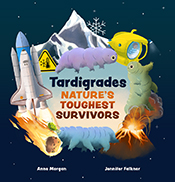Tardigrades: Nature’s toughest survivors by Anne Morgan. Illus. by Jennifer Falkner

It is always a great pleasure to read and learn new and incredible facts about our world. Having no knowledge at all of tardigrades (pronounced TAR-dee-grades), I was truly fascinated to read about these miniscule creatures that can live anywhere in the world and survive extreme temperatures and environments that no other creatures are able to do. A tardigrade is up to about 1 millimetre in length and has a snout, eight tiny legs with claws and a body that ‘looks like a caterpillar in a sleeping bag.’ Tardigrades also have a head and a brain and four body sections. Interestingly there are over 1300 tardigrade species. To see these tiny creatures scientists have had to use a microscope and magnify it up to 100 times. Young readers will enjoy hearing about the eating habits of the tardigrades as they do not have teeth but two sharp sword-shaped stylets that they push out of their mouths to spear their food and then slurp the juices from the cells of other microorganisms they are dining on!
This book provides some interesting and important facts in the final pages followed by a detailed glossary. The colourful front cover and endpapers are striking and throughout the book, the pages are filled with glorious images that complement the well-spaced out and highly accessible text. Scientists are continuing to study tardigrades to learn more about how they survive in remote places, recover from harm and their ability to use suspended animation so I am sure we will be hearing more about these amazing creatures.
Teacher resources are available.
Themes: Animals, Environmental Factors, Survival.
Kathryn Beilby